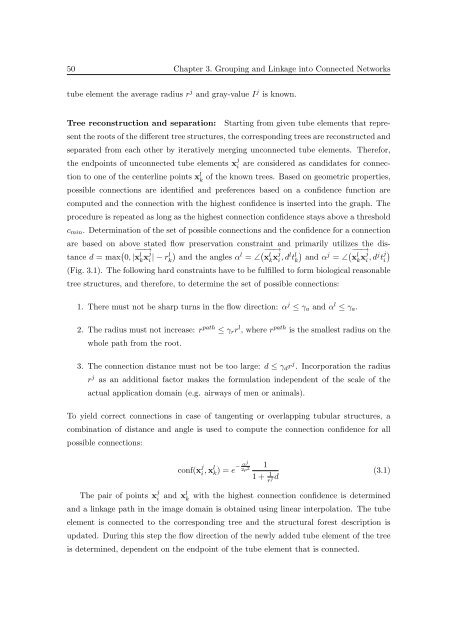Segmentation of 3D Tubular Tree Structures in Medical Images ...
Segmentation of 3D Tubular Tree Structures in Medical Images ...
Segmentation of 3D Tubular Tree Structures in Medical Images ...
You also want an ePaper? Increase the reach of your titles
YUMPU automatically turns print PDFs into web optimized ePapers that Google loves.
50 Chapter 3. Group<strong>in</strong>g and L<strong>in</strong>kage <strong>in</strong>to Connected Networks<br />
tube element the average radius r j and gray-value I j is known.<br />
<strong>Tree</strong> reconstruction and separation:<br />
Start<strong>in</strong>g from given tube elements that represent<br />
the roots <strong>of</strong> the different tree structures, the correspond<strong>in</strong>g trees are reconstructed and<br />
separated from each other by iteratively merg<strong>in</strong>g unconnected tube elements. Therefor,<br />
the endpo<strong>in</strong>ts <strong>of</strong> unconnected tube elements x j i<br />
are considered as candidates for connection<br />
to one <strong>of</strong> the centerl<strong>in</strong>e po<strong>in</strong>ts x l k<br />
<strong>of</strong> the known trees. Based on geometric properties,<br />
possible connections are identified and preferences based on a confidence function are<br />
computed and the connection with the highest confidence is <strong>in</strong>serted <strong>in</strong>to the graph. The<br />
procedure is repeated as long as the highest connection confidence stays above a threshold<br />
c m<strong>in</strong> . Determ<strong>in</strong>ation <strong>of</strong> the set <strong>of</strong> possible connections and the confidence for a connection<br />
are based on above stated flow preservation constra<strong>in</strong>t and primarily utilizes the distance<br />
d = max ( 0, | −−→<br />
x l k xj i | − ) rl k and the angles α l = ∠ ( −−→<br />
x l k xj i , dl t l )<br />
k and α j = ∠ ( −−→<br />
x l k xj i , dj t j )<br />
i<br />
(Fig. 3.1). The follow<strong>in</strong>g hard constra<strong>in</strong>ts have to be fulfilled to form biological reasonable<br />
tree structures, and therefore, to determ<strong>in</strong>e the set <strong>of</strong> possible connections:<br />
1. There must not be sharp turns <strong>in</strong> the flow direction: α j ≤ γ a and α l ≤ γ a .<br />
2. The radius must not <strong>in</strong>crease: r path ≤ γ r r l , where r path is the smallest radius on the<br />
whole path from the root.<br />
3. The connection distance must not be too large: d ≤ γ d r j . Incorporation the radius<br />
r j as an additional factor makes the formulation <strong>in</strong>dependent <strong>of</strong> the scale <strong>of</strong> the<br />
actual application doma<strong>in</strong> (e.g. airways <strong>of</strong> men or animals).<br />
To yield correct connections <strong>in</strong> case <strong>of</strong> tangent<strong>in</strong>g or overlapp<strong>in</strong>g tubular structures, a<br />
comb<strong>in</strong>ation <strong>of</strong> distance and angle is used to compute the connection confidence for all<br />
possible connections:<br />
conf(x j i , αj 1<br />
xl k ) = e− 2ρ 2 1 + 1 d<br />
r j<br />
(3.1)<br />
The pair <strong>of</strong> po<strong>in</strong>ts x j i<br />
and x l k<br />
with the highest connection confidence is determ<strong>in</strong>ed<br />
and a l<strong>in</strong>kage path <strong>in</strong> the image doma<strong>in</strong> is obta<strong>in</strong>ed us<strong>in</strong>g l<strong>in</strong>ear <strong>in</strong>terpolation. The tube<br />
element is connected to the correspond<strong>in</strong>g tree and the structural forest description is<br />
updated. Dur<strong>in</strong>g this step the flow direction <strong>of</strong> the newly added tube element <strong>of</strong> the tree<br />
is determ<strong>in</strong>ed, dependent on the endpo<strong>in</strong>t <strong>of</strong> the tube element that is connected.















